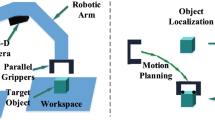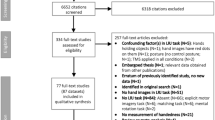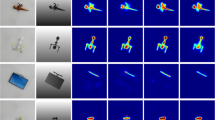Abstract
The aim of the present study was to determine whether kinematic parameters of the grasping motor act are controlled independently of the biomechanical features of the grasping effector. With this purpose in mind, we compared grasping movements performed naturally or using a tool. The tool consisted of two mechanical fingers whose opening and closing phases required squeezing (flexion of the biological fingers) and releasing (extension of the biological fingers) of a handle, respectively. The forces required for opening and closing the mechanical fingers were, respectively, greater and smaller than those used to grasp the objects naturally. In a control experiment the participants grasped with their thumb and index finger the same objects grasped with the tool. The kinematics of the mechanical and biological fingers as well as those of the arm in the two experiments were compared with each other. Grasping an object with the tool showed some kinematic characteristics strikingly similar to those of the natural grasp, whereas others were different. Like the natural grasp, the tool grasp consisted of a finger opening and closing phase. The scaling of both peak velocity of aperture and maximal aperture of the mechanical fingers as a function of object size was the same as that of the biological fingers. In contrast, the tool grasp differed from the natural one for the temporal aspects of the movement. Finally, the initial reach (i.e. the acceleration phase) was poorly influenced by the tool use whereas the final reach (i.e. the deceleration phase) was lengthened and more sensitive to object size. We discuss the results of the present study as being in favour of the hypothesis that some features of the grasp motor representation are coded in cortical areas independently of the used effector. In addition, they suggest a partial independence between the reach and the grasp components.








Similar content being viewed by others
References
Arbib MA (1990) Programs, schemas and neural networks for control of hand movement: beyond the RS frameworks. In: Jeannerod M (ed) Motor representation and control (attention and performance XIII). Lawrence Erlbaum, Hillsdale, NJ, pp 111–138
Arbib MA, Iberall T, Lyons D (1985) Coordinated control programs for movements of the hand. In: Goodman AW, Darian-Smith I (eds) Hand function and the neocortex. Springer, Berlin Heidelberg New York, pp 135–170
Cesari P, Newell KM (2000) Body-scaled transitions in human grip configuration. J Exp Psychol Hum Percept Perform 26:1657–1668
Chieffi S, Gentilucci M (1993) Coordination between the transport and the grasp components during prehension movements. Exp Brain Res 94:471–477
Gentilucci M (2002) Object motor representation and reaching-grasping control. Neuropsychologia 40:1139–1153
Gentilucci M (2003) Object familiarity affects fingers’ shaping during grasping fruit stalks. Exp Brain Res 149:395–400
Gentilucci M, Castiello U, Corradini ML, Scarpa M, Umiltà C, Rizzolatti G (1991) Influence of different types of grasping on the transport component of prehension movements. Neuropsychologia 5:361–378
Gentilucci M, Chieffi S, Scarpa M, Castiello U (1992) Temporal coupling between transport and grasp components during prehension movements: effects of visual perturbation. Behav Brain Res 47:71–82
Gentilucci M, Toni I, Chieffi S, Pavesi G (1994) The role of proprioception in the control of prehension movements: a kinematic study in a peripherally deafferented patient and in normal subjects. Exp Brain Res 102:483–494
Gentilucci M, Toni I, Daprati E, Gangitano M (1997) Tactile input of the hand and the control of reaching to grasp movements. Exp Brain Res 114:130–137
Gentilucci M, Caselli L, Secchi C (2003) Finger control in the tripod grasp. Exp Brain Res 149:351–360
Goodale MA, Meenan JP, Bülthoff HH, Nicolle DA, Murphy KJ, Racicot CI (1994) Separate neural pathways of object shape in perception and prehension. Curr Biol 4:604–610
Iriki A, Tanaka M, Iwamura Y (1996) Coding of modified body schema during tool use by macaque postcentral neurones. Neuroreport 7:2325–2330
Jeannerod M (1988) The neural and behavioural organization of goal-directed movements. Oxford University Press, Oxford
Meulenbroek RG, Rosenbaum DA, Jansen C, Vaughan J, Vogt S (2001) Multijoint grasping movements. Simulated and observed effects of object location, object size, and initial aperture. Exp Brain Res 138:219–234
Mon-Williams M, Tresilian JR (2001) A simple rule of thumb for elegant prehension. Curr Biol 11:1058–1061
Mon-Williams M, Tresilian JR, Coppard VL, Carson RG (2001) The effect of obstacle position on reach-to-grasp movement. Exp Brain Res 137:497–501
Napier JR (1996) The prehensile movements of the human hand. J Bone Joint Surg 38:902–913
Obayashi S, Suhara T, Nagai Y, Maeda J, Hihara S, Iriki A (2002) Macaque prefrontal activity associated with extensive tool use. Neuroreport 13:2349–2354
Oldfield RC (1971) The assessment and analysis of handedness: The Edinburgh Inventory. Neuropsychologia 9:97–113
Paulignan Y, Jeannerod M, MacKenzie C, Marteniuk R (1991) Selective perturbation of visual input during prehension movements. 2. The effects of changing object size. Exp Brain Res 87:407–420
Rizzolatti G, Camarda R, Fogassi L, Gentilucci M, Luppino G, Matelli M (1988) Functional organization of inferior area 6 in the macaque monkey. II. Area F5 and the control of distal movements. Exp Brain Res 71:491–507
Rizzolatti G, Luppino G, Matelli M (1998) The organization of the cortical motor system: new concepts. Electroencephalogr Clin Neurophysiol 106:283–296
Rothwell JC, Taub MM, Day BL, Obeso JA, Thomas PK, Marsden CD (1982) Manual motor performance in a deafferented man. Brain 105:515–542
Sanes RA, Mauritz KH, Dalakas MC, Evarts EV (1985) Motor control in humans with large-fiber sensory neuropathy. Hum Neurobiol 4:101–114
Santello M, Flanders M, Soechting JF (2002) Patterns of hand motion during grasping and the influence of sensory guidance. J Neurosci 22:1426–1435
Smeets JB, Brenner E (1999) A new view on grasping. Motor Control 3:237–271
Smeets JB, Brenner E (2001) Independent movements of the digits in grasping. Exp Brain Res 139:92–100
Smeets JB, Brenner E (2002) Does a complex model help to understand grasping? Exp Brain Res 144:132–135
Tresilian JR, Stelmach GE (1997) Common organization for unimanual and bimanual reach-to-grasp tasks. Exp Brain Res 115:283–299
Wing AM, Fraser C (1983) The contribution of the thumb to reaching movements. Q J Exp Psychol 35:297–309
Woodworth RS (1899) The accuracy of voluntary movement. Psychol Rev 2 Suppl 13
Acknowledgements
We wish to thank F. Grammont for discussion of the experiment and S. Micera for discussion of data and technical support. The work was supported by grants from MIUR (Ministero dell’Istruzione, dell’Università e della Ricerca) and ASI (Agenzia Spaziale Italiana) to M.G. A.C. Roy was supported by the Fyssen Foundation.
Author information
Authors and Affiliations
Corresponding author
Rights and permissions
About this article
Cite this article
Gentilucci, M., Roy, A.C. & Stefanini, S. Grasping an object naturally or with a tool: are these tasks guided by a common motor representation?. Exp Brain Res 157, 496–506 (2004). https://doi.org/10.1007/s00221-004-1863-8
Received:
Accepted:
Published:
Issue Date:
DOI: https://doi.org/10.1007/s00221-004-1863-8




